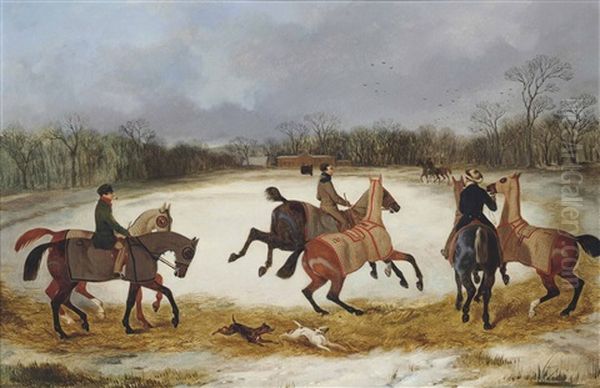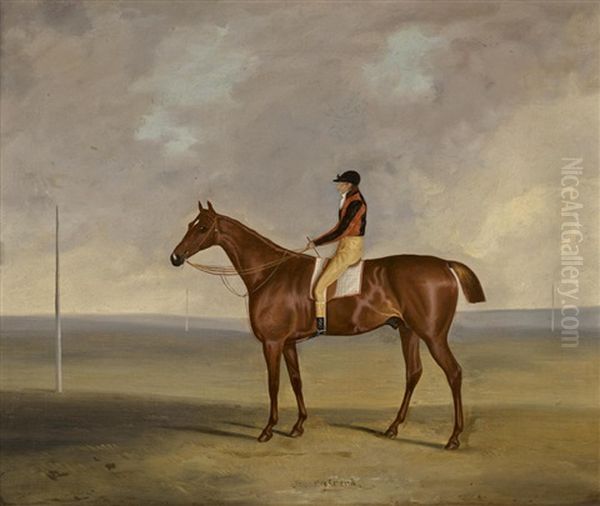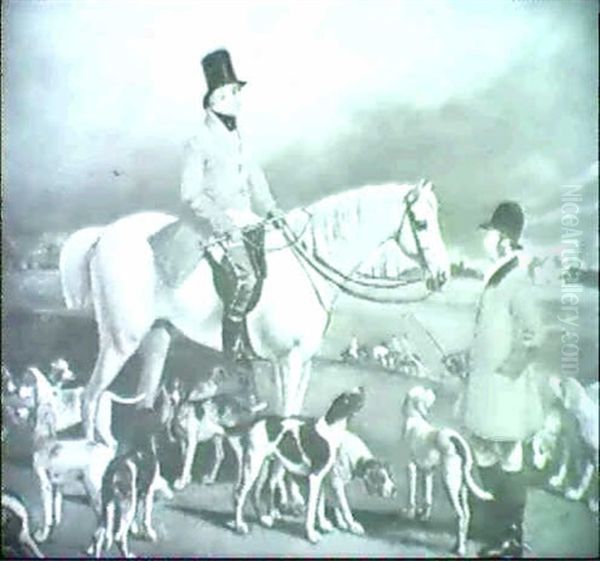David Dalby of York (1794-1836) stands as a significant figure in the rich tradition of British sporting art, a genre that flourished with the passions of a nation deeply invested in equestrian pursuits. Active primarily during the first few decades of the 19th century, Dalby carved a niche for himself as a skilled painter of racehorses, hunting scenes, and animal portraiture, particularly within his native Yorkshire. His work, characterized by an elegant depiction of animals and a sensitivity to landscape, captured the spirit of the turf and the thrill of the chase, earning him a lasting reputation among collectors and regional art institutions.
The Yorkshire Context and Early Career
Born in 1794, David Dalby emerged as an artist in a county renowned for its horse breeding, racing, and hunting traditions. Yorkshire, with its historic racecourses like Doncaster and York, and its sprawling estates ideal for foxhunting, provided a fertile ground for sporting artists. The gentry and burgeoning middle class of the region were enthusiastic patrons, eager to commission portraits of their prized horses or depictions of their sporting triumphs. It was within this vibrant equestrian culture that Dalby honed his skills.
He often signed his works "Dalby York" or was referred to as "Yorkshire Dalby," firmly associating his identity with his geographical roots. While detailed biographical records from this period can be scarce, it is known that he resided in York for much of his career. There is an account of him spending a period in Leeds, a nearby industrial town, and reportedly leaving due to a dispute over a "defamatory portrait," an intriguing but sparsely documented episode that hints at the sometimes-contentious nature of portraiture and reputation in a close-knit society.
Dalby's artistic output peaked notably in the 1820s, a period when British sporting art was arguably at its zenith, with artists like John Frederick Herring Sr. and Henry Alken also highly active. His paintings found their way into numerous private collections, a testament to his popularity among contemporary patrons. Even decades later, in the 1890s, his works were known to command respectable prices, indicating a sustained appreciation for his artistry.
Artistic Style and Thematic Focus

David Dalby's style is often praised for its naturalism and keen observation, particularly in the rendering of equine anatomy and movement. He possessed a talent for capturing the individual character of the horses he painted, imbuing them with a sense of vitality and grace. His compositions typically feature animals in elegant, poised stances, often set against soft, atmospheric landscape backgrounds that evoke the Yorkshire countryside.
His palette, while capable of vibrancy, often leaned towards a harmonious blend of tones that complemented the refined nature of his subjects. There's a delicacy in his brushwork, especially evident in the musculature of the horses and the textures of their coats. This finesse, combined with a strong sense of design, resulted in works that were both aesthetically pleasing and accurate representations of the sporting world.
The primary themes in Dalby's oeuvre were racehorses and hunting scenes. Portraits of specific, often champion, racehorses were a staple. These paintings served not only as records of equine excellence but also as status symbols for their owners. His hunting scenes, filled with the dynamic energy of hounds and horses in pursuit, captured the excitement and traditions of this popular rural pastime. He depicted the various stages of the hunt, from the gathering of the riders to the full cry across the fields.
Representative Works
Several works exemplify David Dalby's skill and thematic preoccupations. "Two Horses Harnessed to a Whitechapel Cart" (1833) is a fine example of his ability to portray working horses with the same attention to detail and character as celebrated racers. The painting depicts two robust chestnut horses, their tack meticulously rendered, ready for an outing, possibly related to a hunt. The Whitechapel cart itself, a light, two-wheeled vehicle, is also carefully depicted, grounding the scene in the everyday realities of sporting life.
"Grooms Exercising Horses in Winter" showcases another facet of his work, capturing a quieter, preparatory moment. The crispness of a winter landscape provides a contrasting backdrop to the warmth and power of the horses being conditioned by their grooms. Such scenes offered a glimpse into the daily routines that underpinned the grand spectacle of race days and hunts.

Dalby also painted numerous portraits of specific racehorses, often commissioned by their proud owners. For instance, he is known to have painted "St Patrick" and "Velocipede" for the prominent racehorse owner Richard Watt of Bishop Burton. These works would have meticulously recorded the conformation and distinguishing marks of these celebrated animals. Works like "Bran" (1834) and a piece titled "Mango" (featured in The Sporting Magazine in 1837, possibly an engraving of an earlier work or a posthumous publication given Dalby's death in 1836) further attest to his engagement with the leading equine figures of his day. These magazine features helped disseminate his imagery to a wider audience.
The Dalby Family of Artists
Artistic pursuits often ran in families during this period, and the Dalbys were no exception. David Dalby's son, John Dalby (c. 1806–1858, though some sources suggest slightly different dates such as 1810-1865), followed in his father's footsteps, also becoming a painter. John Dalby specialized in hunting scenes and, like his father, developed a style noted for its fine detail and dynamic portrayal of animals in motion. His works are sometimes confused with his father's, though experts can often distinguish their hands.
There is also mention of David Dalby's own father being an artist who painted racehorses, including for a patron named William Paget. This suggests a generational continuity of artistic skill within the family, with David inheriting and then passing on the tradition of sporting painting. Other Dalby family members, possibly named Thomas and Joshua, are also sometimes mentioned in connection with painting, though their contributions are less clearly documented than those of David and John. This familial context underscores the craft-based nature of art production in the 19th century, where skills were often transmitted directly from parent to child.
Dalby in the Pantheon of Sporting Artists
To fully appreciate David Dalby's contribution, it's essential to view him within the broader landscape of British sporting art. He was working in a field that had been elevated to a high art form by predecessors like George Stubbs (1724-1806). Stubbs, with his profound anatomical knowledge and classical compositions, set a standard against which all subsequent horse painters were, to some extent, measured. While Dalby may not have shared Stubbs's scientific rigor, he benefited from the increased status Stubbs brought to animal painting.
Among Dalby's near-contemporaries, several artists stand out. Ben Marshall (1768-1835) was a towering figure whose work often possessed a robust, almost sculptural quality and a keen psychological insight into both animals and their human companions. Marshall's influence was pervasive, and Dalby's more naturalistic and less monumental style offers an interesting contrast.

John Frederick Herring Sr. (1795-1865) was an almost exact contemporary of Dalby and one of the most popular and prolific sporting artists of the 19th century. Herring's depictions of St. Leger and Derby winners were widely engraved and immensely popular. Dalby's career, more regionally focused, paralleled Herring's rise, though Herring achieved greater national fame.
The Alken family, particularly Henry Thomas Alken (1785-1851), known as Henry Alken Sr., was renowned for lively, action-packed hunting, coaching, and racing scenes, often imbued with a characteristic vigor and sometimes humor. Dalby's style is sometimes compared to that of the Alkens, especially in the depiction of movement and the arrangement of figures in hunting compositions, though Dalby's work often carries a more serene or elegant air compared to the sometimes boisterous energy of Alken.
Other notable sporting artists of the era include John Nost Sartorius (1759-1828) and his family, who represented an older tradition of sporting painting, and Abraham Cooper (1787-1868), who, like Herring, became a Royal Academician and was highly regarded for his battle scenes as well as his sporting subjects. James Pollard (1792-1867) excelled in depicting coaching scenes and the bustling life of the road, sharing Dalby's eye for equine detail and animated compositions.
Further context is provided by artists like Sawrey Gilpin (1733-1807), an earlier influential figure who brought a romantic sensibility to animal painting, and James Ward (1769-1859), whose powerful and often dramatic animal portraits and landscapes sometimes intersected with sporting themes. Even the great animalier Sir Edwin Landseer (1802-1873), though younger and more focused on Highland scenes and sentimental animal subjects, shared the era's fascination with animals as worthy artistic subjects. The Swiss-born Jacques-Laurent Agasse (1767-1849), who worked in England, also contributed significantly to animal and sporting painting with a distinctive, refined style. Artists like Dean Wolstenholme Sr. (1757-1837) and his son Dean Wolstenholme Jr. (c.1798-1882) were also well-known for their detailed and engaging hunting scenes.
Dalby's work, therefore, fits into a well-established and highly competitive field. His success lay in his ability to create works that satisfied the specific demands of his Yorkshire patrons while maintaining a high level of artistic quality, characterized by elegance, accuracy, and an understanding of his subjects.
Legacy and Collections
David Dalby passed away in 1836, relatively young at the age of 42. Despite his comparatively short career, he left behind a significant body of work that continues to be appreciated. His paintings are held in public collections, notably the York Art Gallery and the Scarborough Art Gallery, which preserve his contribution to the region's artistic heritage. Many more of his works remain in private hands, cherished as family heirlooms or sought after by collectors of sporting art.
His legacy is twofold: firstly, as a skilled chronicler of a specific time and place, capturing the essence of Yorkshire's equestrian culture in the early 19th century. Secondly, as an accomplished artist within the British sporting art tradition, whose depictions of horses and sporting scenes are admired for their grace, detail, and vitality. He successfully navigated the demands of his patrons while producing art that transcended mere documentation, offering an enduring glimpse into the passions of his era.
It is important to note a point of potential confusion for modern researchers: there exists a company named "David Of York Dalby" that produces oil painting reproductions. This entity is entirely unrelated to the historical artist David Dalby (1794-1836) and his original works.
Conclusion
David Dalby of York was more than just a provincial painter; he was a talented artist who made a distinctive contribution to one of Britain's most beloved artistic genres. His paintings of racehorses, hunters, and sporting scenes are characterized by an elegance, an observational acuity, and a sensitivity to the nuances of animal form and movement. Working within the heartland of British equestrianism, he provided his patrons with images that celebrated their prized animals and their cherished pastimes. While perhaps not as widely known nationally as some of his London-based contemporaries, Dalby's work holds an important place in the story of Yorkshire art and the broader narrative of British sporting painting, reflecting a world where the horse was king and its depiction a high calling. His art remains a vibrant window onto the sporting life of early 19th-century England.